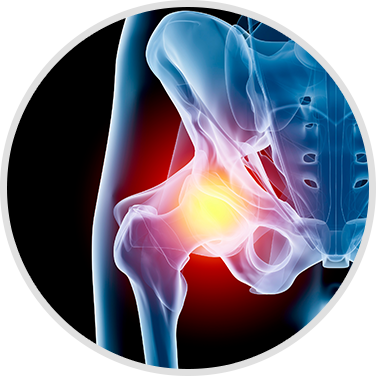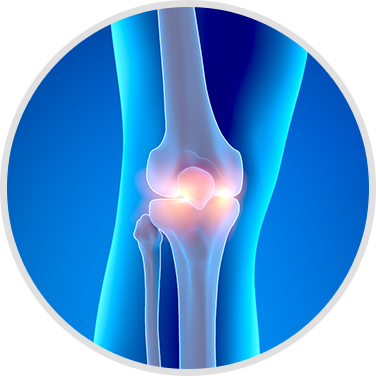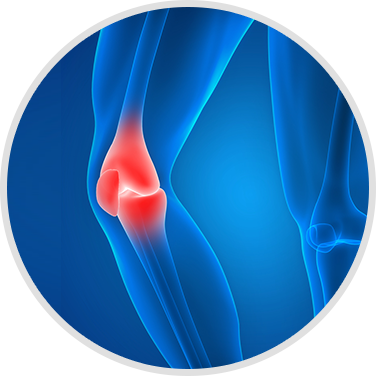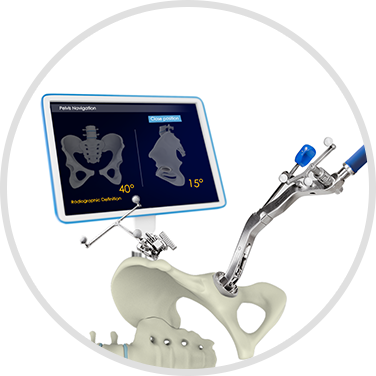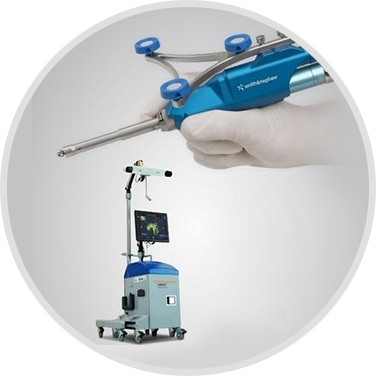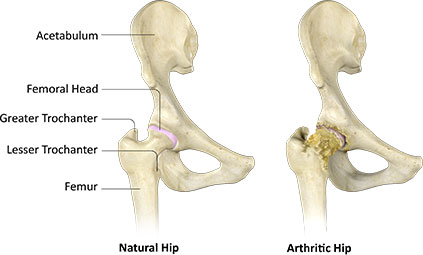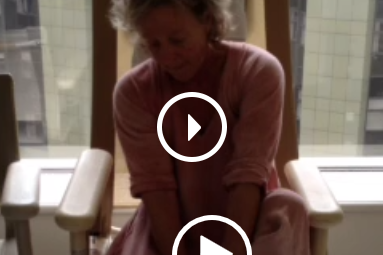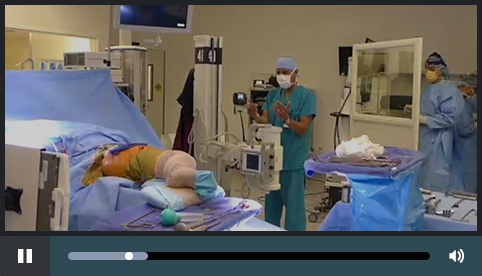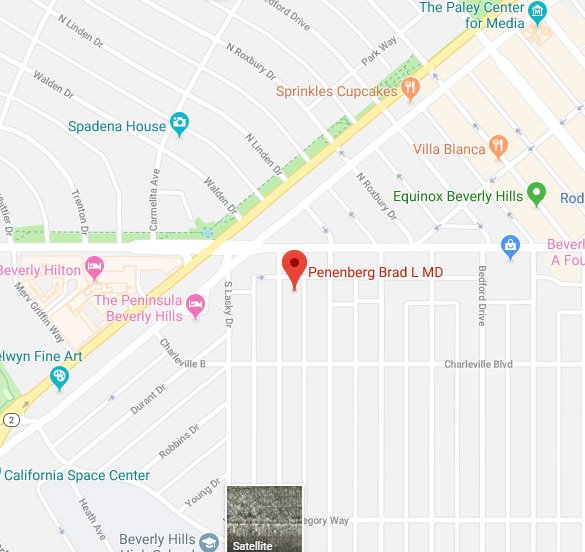Hip
The ability to enjoy life’s activities and move without pain.
Something important to everyone in every age group. Something you take for granted until osteoarthritis takes away your freedom of movement. Daily activities like walking, or sitting comfortably in a chair, or shopping, have become a struggle.
When your hip was healthy, the movement of bending, straightening, and twisting was absorbed by the cartilage. Cartilage, the cushion between the bones, allowed the ball to move freely in the socket.
When the cartilage is worn away, or is damaged, bones rub against each other, causing pain and inflammation, and the condition is referred to as osteoarthritis or inflammation.
The painful, arthritic hip is replaced with an implant or device referred to as prosthesis. Most often, the femoral head is ceramic or on occasion, it may be cobalt chrome; however, Dr. Penenberg likes to use a plastic highly cross-linked polyethylene line. All materials have been extremely successful, or durable over the last 15 years, and based on this history, are likely to last as long as 20-30 years. Dr. Penenberg’s incision to implant the prosthesis is approximately 3 to 5 inches long.
The Portal Assisted Total Hip (PATH) replacement has freed patients from the pain and the stiffness. The new technique for hip replacement, minimally invasive surgery (MIS), has quickened recovery, and restored lost freedom in a shorter recovery time than traditional hip replacement surgery.
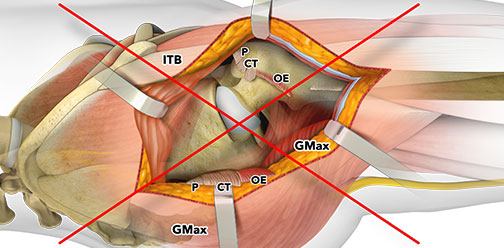
Traditional open posterior THA is no longer required and has not been performed by Dr. Penenberg in more than 14 years.

Patented Portal Assisted Superior Total Hip allows preservation of tendon attachments
Dr. Penenberg's PATH technique, like the anterior approach, preserves muscle strength and early function, by preserving the Iliotibial band (ITB). Cutting the ITB as in the traditional posterior approach leads to increased blood loss, slower recovery, longer time on support, higher risk of dislocation, and greater need for narcotic pain medication.
Sparing ITB:
- Allows same day discharge in most cases
- Preserves muscle strength
- Dramatically reduces pain and need for narcotic pain medication
- Reduces time on assistive device
- Allows for immediate range of motion exercises will elimination of the traditional precautions
DIRECT SUPERIOR VS ANTERIOR APPROACHPATH (Postal Assisted Total Hip) technique has shown that simpler clinical results can be achieved without the same risks associated with the anterior approach.
Anterior Approach
- Accelerated recovery and potential for same day discharge
- Harder visualization of femur
- Scar is in the front of the thigh
- Nerve is at risk of leading to thigh numbness 65% of the time
- Special traction table is needed for operation and it has been associated with ankle and femur fractures
- More potential for greater blood loss
- Harder technique for obese and muscular patients
- More radiation due to use of flouroscopy
- Post Surgery wound problems and higher rate of infection
- Higher risk of femoral component loosening
vs Superior Portal Assisted Approach
- Accelerated recovery and potential for same day discharge
- Easy direct access to femur
- Scar is less apparent because of location off to the side
- Thigh numbness extremely unlikely because skin nerve not in area of the incision
- Patented computer guided technology which enables precise component placement without the use of flouroscopy
- Low radiation digital imaging allowing more accurate assessment of limb length and component position
- Portal use for any size patient/degree of deformity. Eliminates the need for traction table
- Extremely low infection and dislocation rate
Hip Revision
- The majority of hip replacement patients will never need a revision. A hip replacement may fail for a number of reasons, and fortunately, revision surgery will correct most of these problems.
- Not all orthopedic surgeons perform hip revision surgery. Surgical solutions for failed hip prosthesis may be simple or complex. The surgeon’s experience with revision surgery is paramount to a successful outcome.
- Penenberg has extensive experience with hip revision surgery. Patients are referred to him for evaluation from all over the World. His experience includes simple revisions and complex revisions.
- Example 1: A simple revision would be a liner of femoral head exchange a result of plastic or polyethylene wear.
- Example 2: A complex revision might be the result of trauma or component loosening requiring autograft and allograft supplementation for bone deficiency.
- Example 3: Infected Total Joint Replacement
- Dr. Penenberg has a special interest and expertise in the treatment of hip replacement patients with joint infections. He works with a team of specialists in infectious disease and internal medicine to plan an often complex course of treatment in effort to eradicate the existing infection which typically leads to successful re implantation of a new THA potentially reimplant a hip prosthesis.
My Life depends on being in and around the ocean, Dr. Penenberg got me back into the Ocean in less then three months,with out having to take any Narcotics
Larid Hamilton, Larid Hamilton Surf Company
Robotic vs Computer Guided
All though there have been many attempts at applying robotics in total hip replacement surgery significant draw backs remain.
- CT scan is required for robotically assisted THA with much greater radiation 18 times the amount of a single xrays.
- Surgery time 32 minutes longer according to recent studies.
- No advantage when compared to Dr. Penenberg’s digital imaging technology
Dr. Penenberg utilizes computer guidance in the form of digital radiography in an effort to provide the greatest likelihood of :
- Correct component placement and alignment
- Correct component sizing
- Limb length optimization
- Confirms all the desired parameters such as orientations of acetabular component
- No advantages in its current form
In its current form in 2016, there are no outcome advantages in the use of robotics over Dr. Penenber’s computer guided PATH technique.
Stem Cell vs Hip Replacement
Although offered by many practitioners, stem cells have not shown any effectiveness in slowing the progression of osteoarthritis or growing new cartilage. The symptoms associated by bony erosion and articular cartilage loss (main features of OA) cannot be reliably alleviated by any known means other than hip replacement.
Frequently Asked Questions
What does MIS stand for?
MIS is the abbreviation for Minimally Invasive Surgery.
How does the MIS procedure differ from the usual/traditional procedure for hip or knee replacement?
When using the MIS procedure, Dr. Penenberg makes a significantly smaller incision, and cuts less soft tissue. The result is significantly less trauma to the soft tissue at the surgical site. This means significantly less bleeding, less pain, and less swelling. Less pain and swelling results in a shorter hospital stay, and a quicker recovery. You may be able to return to your regular activities within 3 to 5 weeks, as opposed to the 3 to 4 months it takes to recover from the traditional approach.
Is the MIS approach the same as arthroscopic surgery?
No. Arthroscopic surgery is performed on the soft tissue using a camera through a tiny incision. It is not applicable to joint replacement surgery.
What are the risks of joint replacement surgery?
There are three risks associated with joint replacement:
- Hip dislocation:when the replacement ball pops out of the replacement socket. We have not seen this occur while using the MISapproach.
- Infection:Dr. Penenberg takes active measures to reduce the risk of infection. Joint replacement surgeries are performed in special operating rooms with laminar flow – an air exchange system that cleans the air.He also administers intravenous antibiotics before and after the procedure to protect against infection.
- Deep vein thrombosis (DVT)/postoperative blood clots:Dr. Penenberg starts blood thinning medication the day after surgery. These medications help prevent the formation of blood clots. The MISprocedures allow the patient to be more active, sooner after surgery. The increased mobility is also a significant factor in decreasing the incidence of blood clots.
How do I know if I’m a candidate for the MIS procedure?
Dr. Penenberg can determine if you are a candidate for the MIS hip or knee procedure on your initial evaluation. X-rays will determine if there is bone damage necessitating joint replacement, and the X-rays and the examination can determine if you are a candidate for the MIS approach.
Will my insurance cover MIS joint replacement surgery?
You can contact our billing department directly to answer any financial questions. MedNet Billing, Inc. 310.322.4278.
How long will I be in the hospital?
For primary joint replacement patients (hip or knee), the hospital stay is 1 to 3 days; however, some hip replacement can be done at an outpatient facility and discharged the same day. Patients having revision surgery may have a shorter or longer stay depending on the necessary procedure.
Do I need to donate my own blood before surgery?
No. The MIS procedure results in less trauma to the tissues, and less blood loss.
How long does the surgery take?
Dr. Penenberg performs the MIS joint replacement surgery in a little over an hour. Actual time in the operating room is about 2 hours given the setup time and the time the anesthesiologist is working with you.
What should I bring to the hospital?
Personal toiletries. CD player/ book/magazine – to help pass the waiting time getting ready to go into the operating room. Loose fitting, comfortable clothing. Insurance cards/ photo I.D. A list of all the medications you are taking – prescription and over the counter. The only medication you should bring is prescription eye drops or inhalers. Shoes or slippers that enclose the entire foot – no mules, clogs, or flip flops. Walker/crutches/cane – do not bring on the day of surgery. Ask a family member or friend to bring the next day.
Will I be able to climb stairs after surgery?
Yes! The Physical Therapist at the hospital will instruct you, and you will practice stairs, before you leave the hospital.
Will I stay in the hospital for rehabilitation?
Cedars-Sinai Medical Center does have a rehabilitation center. However most patients recover quickly, and do not need this service. Patients usually go home with home Physical Therapy (set up by the hospital). If you need outpatient rehabilitation, we will provide you with a list of rehabilitation centers. If you have private insurance, it is IMPERATIVE that you contact your insurance company to learn which rehabilitation facilities are covered by your policy.
How long will the prosthesis last?
The hip prosthesis is expected to last 25 years or more. The knee prosthesis is expected to last 15 – 20 years. Components can be replaced as necessary.
Will the prosthesis set off the metal detector at the airport?
The prosthesis can/may set off the metal detector. To-date, there have been no problems with delays or missing flights. You are simply “wanded,” then allowed to proceed.
Am I able to resume sexual activity after surgery?
You may return to your regular activities as soon as you feel able, but with some caution. The joint will be tender, and it is best to keep pressure off of it while the soft tissue heals. Ask the surgeon or the nurse about safe positions that will accommodate your new joint.
How long will I have to be in Physical Therapy?
The time spent in Physical Therapy depends on the individual and the demands of his/her activities and occupation.
Can all orthopedic surgeons perform MIS joint replacements?
No. Surgeons must receive specialized training.

